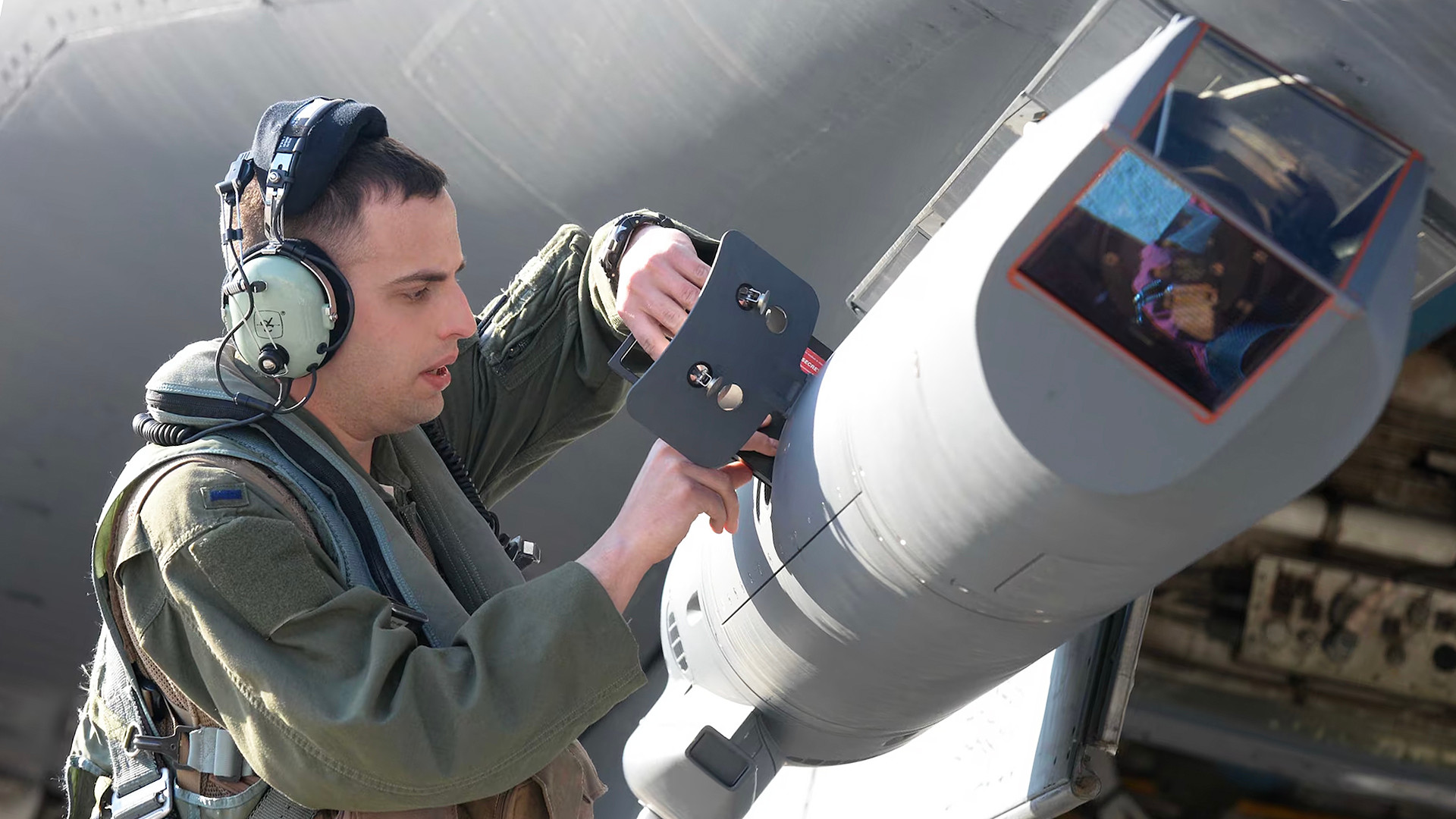Lockheed Martin has rolled out a new version of its Sniper targeting pod with added networking capabilities primarily designed to provide a secure link between non-stealthy fourth-generation fighters like the F-16 Viper and stealthy F-35 Joint Strike Fighters. However, the pod can also exchange information with other assets in the air and on the ground, including artillery units. As such, it offers the ability to act as a hub in its own miniature ‘kill web’ that could provide immense advantages to friendly forces in the air and down below.
Unveiled earlier this week at the biennial Farnborough Air Show in the United Kingdom, the Sniper Networked Targeting Pod retains the same targeting functionality found in the preceding Sniper Advanced Targeting Pod (ATP). In its existing form, Sniper ATP features electro-optical and infrared video cameras, a laser spot tracker and designator, and the ability to generate target coordinates for GPS-guided munitions. It can also be used for more general air-to-ground surveillance and reconnaissance tasks and offers a secondary air-to-air target detection and identification capability. Beyond steering its sensors manually, it can be cued to an object of interest via other systems on the host aircraft, such as its radar or a pilot’s helmet-mounted display.

The new networked version of the pod, development of which began in the middle of last year, has the same general form factor as its predecessor, but with the particularly prominent addition of a conformal antenna on the bottom, as seen in the graphic below. With help from the Skunk Works advanced projects division and other parts of the company, it took Lockheed Martin less than half a year to produce a prototype of the system for flight testing.

The pod’s “advanced datalink compatible with the F-35 will allow seamless sharing of target and surveillance information between aircraft,” according to a Lockheed Martin press release. “A Mobile Ad-hoc Network (MANET) radio, meanwhile, will support a decentralized but highly secure mesh network of multiple air, ground, and sea platforms ready to share and act on that information.”
Though not stated here, the clear implication is that the pod will be able to send and likely receive transmissions to and from the Multifunction Advanced Data Links (MADL) found on all three current variants of the F-35. Fourth-generation combat jets and other aircraft already have the ability to communicate with F-35s via the Link16 waveform, but doing so in a two-way ‘send and receive’ fashion can leave a stealthy aircraft vulnerable. MADL is currently only in frontline service on the Joint Strike Fighter, but could also be a feature on the U.S. Air Force’s forthcoming B-21 Raider stealth bombers. Additionally, drones intended to work with stealthy assets like the F-35 are likely to leverage MADL networking, as we have already seen in testing.
What makes being able to communicate with F-35s via MADL so important is that it is a low probability of intercept/low probability of detection (LPI/LPD) system that also broadcasts in a highly directional way. These features make it extremely hard to detect and jam. By comparison, using omnidirectional Link16 significantly increases the chance of enemy forces detecting the otherwise stealthy Joint Strike Fighters and offers an additional way for opponents to track their movements, as well as being more susceptible to jamming.

MADL’s reach can be extended by ‘daisy chaining’ together multiple aircraft equipped with the system, pushing back critical data collected deep in denied airspace to more permissive airspace for further distribution and exploitation. With this new pod, two F-35s could send information from very deep inside enemy territory, relaying it from one F-35 to another F-35, or stealthy drone, and then back to a fourth-generation fighter equipped with the networked Sniper pod, which can then leverage it for its own use and/or send that information wherever else it needs to go.
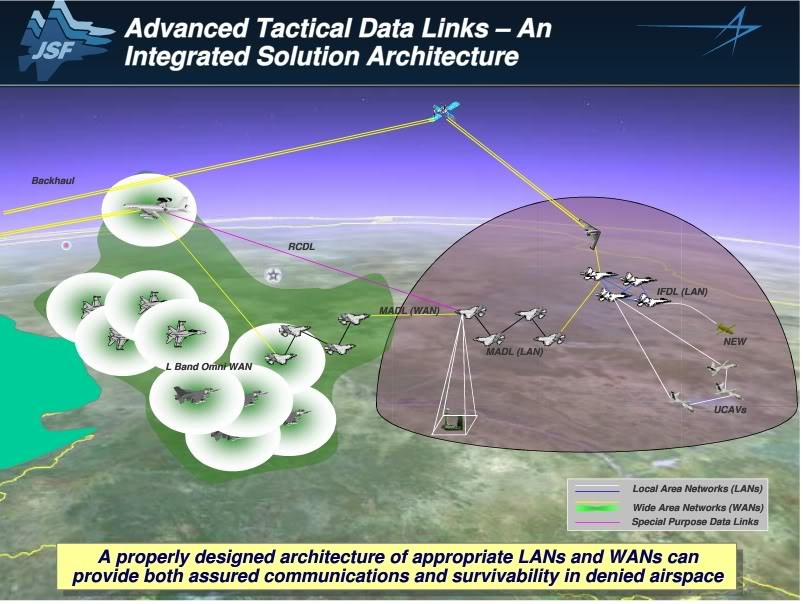
The recipient of the data from the networked Sniper pod could be a long-range missile battery, for instance. In such a scenario, an F-35 could have spotted a surface-to-air missile system deep inside enemy territory that it wants killed. That data could be passed back to another F-35 and then onto an F-16, or another fourth-generation fighter equipped with the pod like a Eurofighter Typhoon, which then passes it to a long-range guided missile battery on the ground in friendly territory. The missile is fired and the target is eliminated, with the F-35 gathering intelligence as to the success of the strike and also passing that back along the chain.
So we are talking about a very flexible, but self-contained and relatively affordable advanced networking architecture here, as fourth-generation jets already carry targeting pods and F-35s have MADL baked in.
Lockheed Martin, in cooperation with the U.S. Air Force, has already demonstrated the ability for F-35s to communicate with fourth-generation fighters and other platforms via MADL using intermediary networking gateways, including ones carried on U-2S Dragon Lady spy planes and XQ-58 Valkyrie drones. This has been enabled in part by advances in ever smaller form factor software-defined radios that can be more readily tuned to transmit and receive different waveforms. Still, this is not the same as deploying a capability to share targeting data between fourth and fifth-generation fighters via a targeting pod, which is a feature already flying on most fourth-generation fighter aircraft.
The Sniper Networked Targeting Pod press release offers one notional vignette highlighting how the system might open up entirely new tactical opportunities that is similar to the one we’ve described already. The pod would enable “F-35 multirole fighters and their advanced sensors” to operate in their most stealthy mode and act “as forward observers that identify and track targets while sharing precise coordinates with F-16s and ground-based Command and Control Systems that allow the employment of MLRS [Multiple Rocket Launch System] family of munitions from either [the] HIMARS [High Mobility Artillery Rocket System] or M270.”
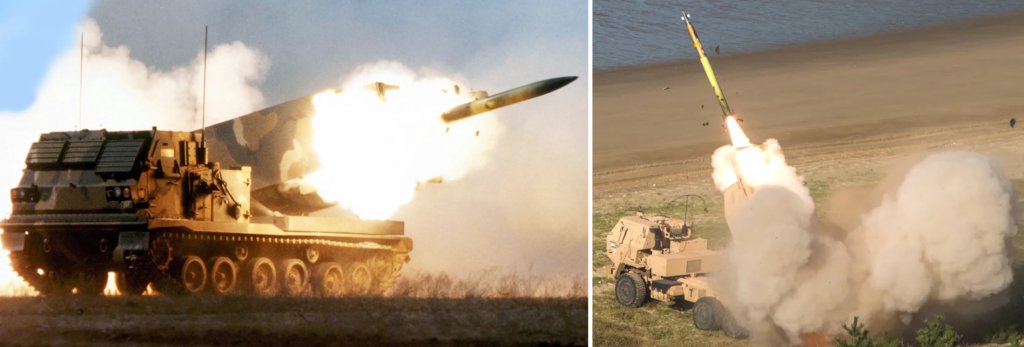
Lockheed Martin has previously outlined a similar scenario involving F-35s flying within a hostile air defense bubble forwarding targeting information about enemy locations that are then struck by Precision Strike Missiles (PrSMs), but without the added help the networking capabilities on the new Sniper pod offers. The M142 HIMARS and the M270 MLRS launchers can fire a variety of guided 227mm artillery rockets, as well as Army Tactical Missile System (ATACMS) and now PrSMs, both of which are short-range ballistic missiles. Lockheed Martin is the current prime contractor for the M142 and M270 and all of these munitions, as well as the F-16 fighter.
The Sniper Networked Targeting Pod mounted on an aerial platform that acts as a relay positioned well behind the F-35 could allow for the execution of the same general scenario outlined in the press release, but utilizing the magazines of a wide array of combat aircraft and ground-based standoff weapon systems. The host aircraft for the pod would also provide much greater line-of-sight connectivity over long distances than what an F-35 would have connecting to systems on the ground directly, allowing the Joint Strike Fighter to make the best use of its specific array of stealth, sensor, and capabilities. Overall, the fact that F-35s would not be limited by their own magazine depth and would be able to exploit their incredible sensor reach and ability to penetrate into hostile territory even after their own weapons stores run dry, bringing weapons fired from other platforms to bear on targets it spots, is a major leap in capability.
The promotional material for the new pod highlights how “27 countries deploy [the existing] Sniper [ATP] on F-16, Eurofighter Typhoon, Rafale, Mirage [2000], FA-50, F-15, and F-18 aircraft.” Sniper has been integrated onto other aircraft beyond fourth-generation fighters, as well, including U.S Air Force B-1 and B-52 bombers. So, any of these aircraft could leverage the new networked system. Integrating Sniper onto new platforms is a well-known exercise at this point, too. Just strapping this pod to an MQ-9 Reaper, for instance, would provide instant networking relay capability and also another sensor to leverage by its operators.
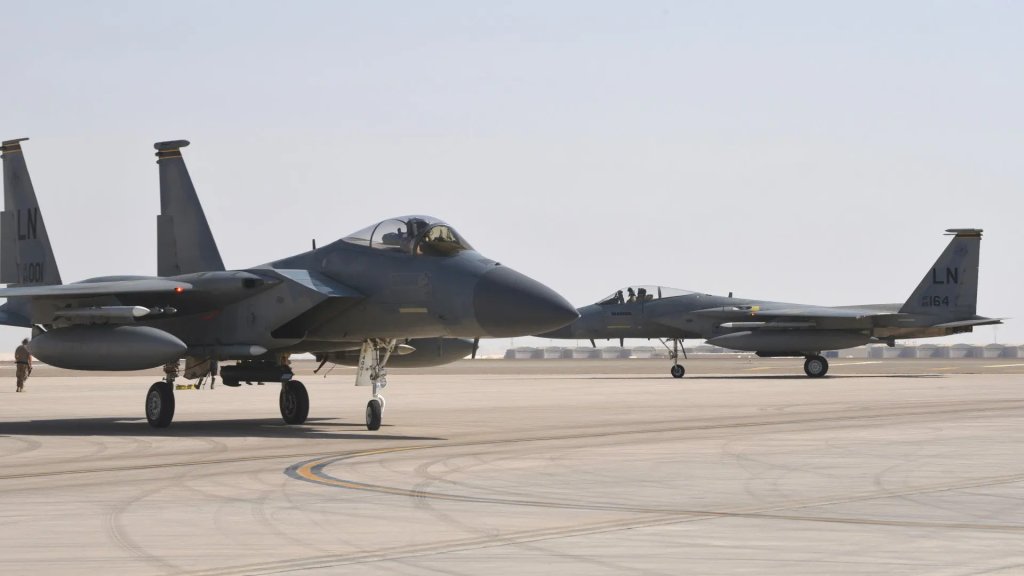
The new Sniper derivative could work within other kill chains, as well. F-35s could conceivably pass targeting data about aerial threats to various other nodes in the air and on the ground via the pod. This could allow other platforms to engage hostile aircraft and missiles beyond the reach of their own on-board sensors.
For instance, an F-35 flying forward could potentially cue a Patriot long-range surface-to-air missile system to a particular target that its organic radars cannot ‘see.’ As part of a Lockheed Martin test called Project Riot in 2019, an F-35 passed information about a simulated ballistic missile launch to missile defense assets via a U-2S acting as an airborne communications relay node and a control center on the ground. This new Sniper pod derivative could potentially support just these kinds of engagements without the need for a high-flying U-2, a fleet that is already small and is now facing the prospect of retirement. Having entire fleets of fourth-generation fighters equipped with this capability could be a game changer for deploying mini-kill webs wherever they are needed most.

F-35s flying over contested territory would provide a look-down radar surveillance capability that could be extremely important for the defense against cruise missiles and drones. The F-35s could spot these threats and even positively identify them using their Electro-Optical Targeting Systems (EOTS), and pass targeting tracks back to long-range SAM batteries to take them out. Once again, the F-35’s greatest use would be acting as a forward sensor node and battle manager of sorts in such a scenario. For many countries that do not possess airborne early warning and control aircraft, just securely obtaining the F-35’s situational awareness data of the air ‘picture’ in real-time would be incredibly valuable.
“If you look at what we’re able to do now with IBCS [the Integrated Air and Missile Defense Battle Command System] – you know, we’re able to have a fighter with an AESA [active electronically-scanned array] radar feed directly… through the IBCS network” to a Patriot surface-to-air missile system, itself linked to an LTAMDS radar, and “be able to fire off that fire control quality data,” U.S. Army Lt. Gen. Sean Gainey, head of that service’s Space and Missile Defense Command (SMDC), highlighted at a talk just this week. “So now it’s just opening that aperture and being able to do it across [the] services.”

Given that the first Sniper Networked Targeting Pod came amid the Farnborough Air Show, which opened on Monday, it’s not surprising that Lockheed Martin is already heavily pitching it to NATO members. As of April, 12 nations in the alliance had F-35s in service or on order. Greece just recently moved to join this group.
“The F-35 is the aircraft of choice for allies across NATO. By 2035, there will be more than 600 F-35s in the European region,” J.R. McDonald, Lockheed Martin’s Vice President of F-35 Business Development, said in a statement. “The enhanced capabilities the Sniper targeting pod can bring will serve to further enhance the connectivity and interoperability the F-35 brings to current and future customers.”
Many NATO members who are now operating or working to acquire F-35s continue to operate fourth-generation combat jets, including F-16 variants, as well. Poland, for instance, which is in the midst of a massive military modernization push across the board, expects to continue flying its late-block F-16C/Ds alongside a future fleet of F-35 “Husarz” and FA-50 light fighters for the foreseeable future. Poland is also fielding the aforementioned IBCS network, the full capabilities of which you can read more about here. The new version of the Sniper pod could be tied into this architecture, but just as a standalone capability, it could unlock the potential of its fighter fleet at a relatively low cost.
The Eurofighter Typhoon is also in widespread service with NATO partners and the Sniper pod is already available for those aircraft. The new pod could pair the Typhoon and F-35 forces together in a newly connected manner, opening up an extremely potent mix of fighter capabilities. And for countries that do not have the F-35, providing the capability to connect others’ Joint Strike Fighters with their fourth-generation jets would be prized by the alliance. Linked together, multiple fourth-generation fighters with these pods could potentially create something of an ad-hoc mesh network, or ‘active net,’ across a broader area.

There are a steadily growing number of mixed fleet F-35 operators outside of NATO (and Europe) that could be interested in the capabilities that the new networked Sniper pod offers. South Korea, Singapore, Israel, Japan, and Australia are just a handful that come to mind.
The ability to incorporate the new networking capabilities into a modified version of the Sniper ATP also highlights the potential for further functionality to be added in the future. Lockheed Martin’s promotional material notes that the Sniper family already offers “flexible architecture within the self-contained pod [that] lets users quickly add new capabilities.” Keeping to the same Sniper ATP form factor, at least generally, means that flight testing can be cut back considerably while still adding new capabilities.
We have already seen other pods in the past tout similar open-architecture and modular designs that could be adaptable to multiple different mission requirements. As a prime example, the Legion Pod, another Lockheed Martin product primarily offered as an infrared search and track (IRST) system, has also gotten important additional networking capability in recent years.
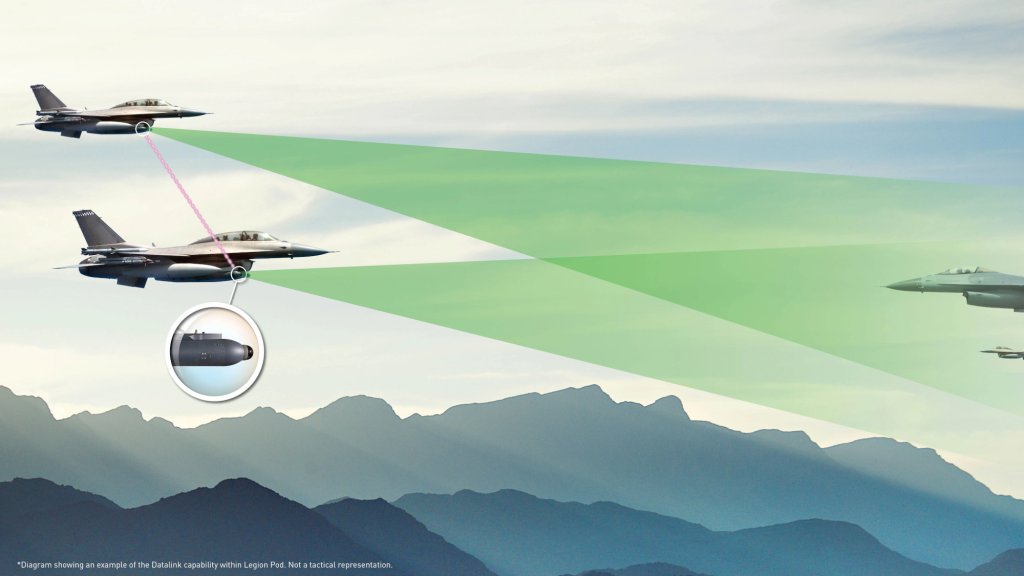
The LITENING targeting pod, Sniper’s chief competitor now, has been receiving substantial upgrades in recent years, too. LITENING was originally developed by Israel’s Rafael and that company in cooperation with Northrop Grumman in the United States continue to offer improved versions for use in combat jets and other aircraft. These pods can also be offered with small radars and other sensors installed within their original form factor.
As it sits now, the fully networked Sniper pod will soon be put through end-to-end tests including both F-35, host platform, and ground-based ‘shooter’ elements. But even this early on, interest is said to be very high. Above all else, Lockheed Martin has used this program to show how fast they can move when the opportunity presents itself to bring major capability boosts under very tight timelines and without massive program costs. Considering what has happened with Ukraine, the need for exactly these types of force multiplication capabilities, especially having to do with long-range fires, are on the top of the wish lists of many air arms, both big and small.
With all this in mind, don’t be surprised to see Sniper Networked Targeting Pods flying on aircraft in the not-too-distant future.
Contact the author: joe@twz.com
